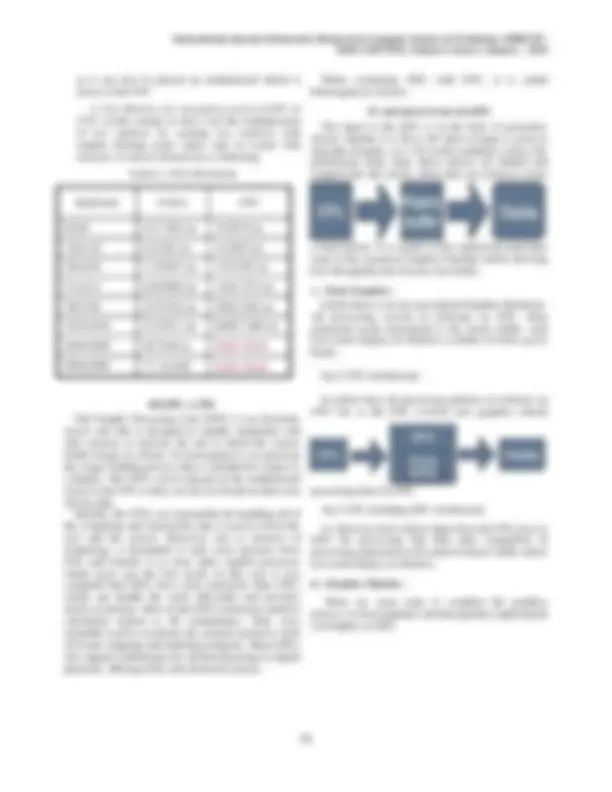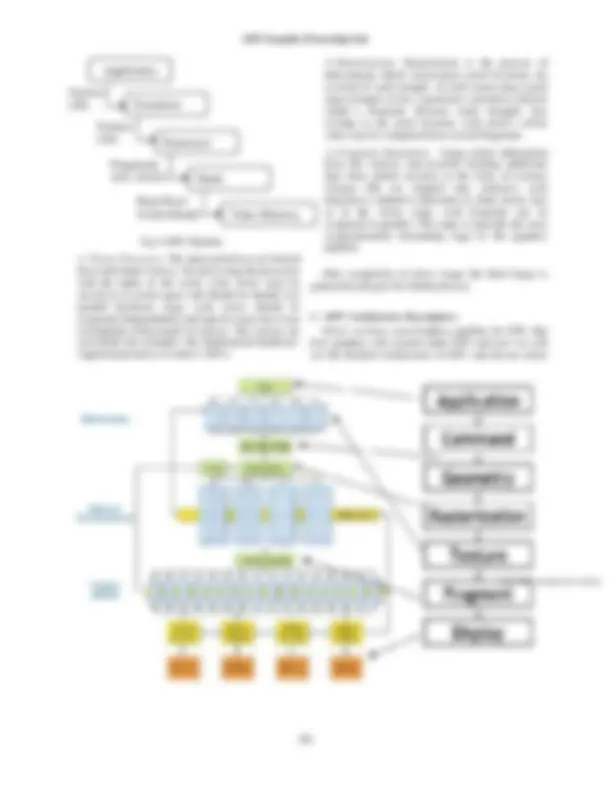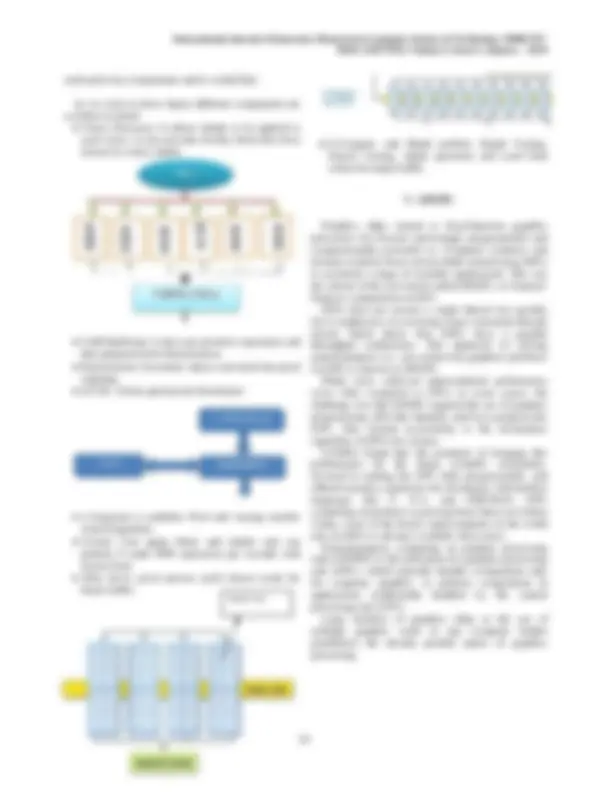





Study with the several resources on Docsity

Earn points by helping other students or get them with a premium plan


Prepare for your exams
Study with the several resources on Docsity

Earn points to download
Earn points by helping other students or get them with a premium plan
Community
Ask the community for help and clear up your study doubts
Discover the best universities in your country according to Docsity users
Free resources
Download our free guides on studying techniques, anxiety management strategies, and thesis advice from Docsity tutors
An overview of GPU computing, its advantages, and its history. GPUs are massively multi-threaded architectures designed for parallel processing, making them ideal for graphical and non-graphical computations. They offer significant improvements in floating point operations per unit time compared to CPUs, increasing hardware capabilities and programmability. GPU computing is a powerful combination with CPUs, with GPUs handling parallel processing and CPUs handling serial processing.
What you will learn
Typology: Lecture notes
1 / 7

This page cannot be seen from the preview
Don't miss anything!




International Journal of Innovative Research in Computer Science & Technology (IJIRCST) ISSN: 2347-5552, Volume-3, Issue-1, January – 2015
Ramani Shrusti K., Desai Vaishali J., Karia Kruti K. Department of Computer Science, Saurashtra University Rajkot, Gujarat. Abstract — In this paper we describe GPU and its computing. GPU (Graphics Processing Unit) is an extremely multi-threaded architecture and then is broadly used for graphical and now non- graphical computations. The main advantage of GPUs is their capability to perform significantly more floating point operations (FLOPs) per unit time than a CPU. GPU computing increases hardware capabilities and improves programmability. By giving a good price or performance benefit, core-GPU can be used as the best alternative and complementary solution to multi-core servers. In fact, to perform network coding simultaneously, multi core CPUs and many-core GPUs can be used. It is also used in media streaming servers where hundreds of peers are served concurrently. GPU computing is the use of a GPU (graphics processing unit) together with a CPU to accelerate general- purpose scientific and engineering applications. GPU was first manufactured by NVIDIA. CPUs have few cores which is used for serial processing and GPUs have thousands of smaller cores which are more efficient, designed for parallel processing. So, CPU + GPU is a powerful combination. Whenever the code is run on the machine, CPU runs serial portion and GPU runs parallel portion. GPU is used for general purpose applications like arithmetic and it is also used for gaming. Keywords — CUDA, GPU, GPGPU, NVIDIA I. INTRODUCTION Parallelism is the future of computing. Future microprocessor development efforts will continue to concentrate on adding cores rather than increasing single-thread performance. It can be possible through GPU. Graphics Processing Unit (GPU) is a massively multi-threaded architecture and then is widely used for graphical and now non-graphical computations. Graphics Processing Units (GPUs), works with Central Processing Units (CPUs) in PCs, are special purpose processors designed to efficiently perform the calculations necessary to generate visual output from program data. GPU has become into a powerful programmable processor, with both application programming interface (APIs) and hardware increasingly focusing on the programmable aspects of the GPU, so result is a processor with enormous arithmetic capability is GPU. GPU is a processor generally used for display, video, 2D/3D graphics and visual computing. It is parallel, multithreaded multiprocessor used for visual computing. It also provide real-time visual interaction with computed objects via graphics images, and video.GPU serves as both a programmable graphics processor and a scalable parallel computing platform. Graphics Processing Unit is also called Visual Processing Unit (VPU) is an electronic circuit designed to quickly operate and alter memory to increase speed the creation of images in frame buffer intended for output to display. A. History : Nvidia is The First vender of GPU and the term GPU was popularized by Nvidia in 1999 who marketed the GeForce 256 as "the world's first 'GPU', or Graphics Processing Unit, a single-chip processor with integrated transform, triangle setup/clipping, lighting and rendering engines that are capable of processing a minimum of 10 million polygons per second". Another Rival vender ATI Technologies gave the term Visual Processing Unit or VPU with the release of the Radeon 9700 in 2002. In following table we can see the evaluation of GPU from 1980 to Present. TABLE- 1 --EVALUATION OF GPU
GPU-Graphics Processing Unit Fig. 1 Cores in CPU and GPU II. WHAT IS GPU GPUs have evolved to the point where many real- world applications are easily implemented on them and run significantly faster than on multi-core systems. In future hybrid systems will be seen with parallel core GPUs working simultaneously with multi core CPUs. A. Characteristics of GPU : The GPU is designed for a particular class of applications with the following characteristics. In the last few years, it has been identified that other applications also exists with similar characteristics and such applications can be mapped on to the GPU.Computational requirements are large. Real time performance needs millions of pixels per second and each pixel needs hundreds or more operations. To successfully complete the demand of complex real time applications GPUs must provide large amount of compute performance. Parallelism is substantial. Fortunately, the graphics pipeline is well suited for parallelism. Operations on vertices and fragments are well matched to fine-grained closely coupled programmable parallel compute units, which in turn are applicable to many other computational domains. Throughput is more important than latency. GPU implementations of the graphics pipeline prioritize throughput over latency. Generally in millisecond time scales the human visual system performs while operations within a modern processor take nanoseconds. This difference creates six-order-of- magnitude gap which means that latency of any operation is not important. B. Why GPU? Nowadays single processing is timing, so current market is up for parallel processing. The demands placed on GPUs from their native applications are, however, usually quite unique, and as such the GPU architecture is quite different from that of the CPU. Graphics processing is inherently extremely parallel so can be highly threaded and performed on the large numbers (typically hundreds) of processing cores found in the GPU chip. So we can say that CPUs are great for Task Parallelism and GPUs are great for Data Parallelism. 1) Task Parallelism : Distribute the tasks across processors based on dependency. Coarse-grain parallelism. 2) Data Parallelism : Run a single kernel over many elements. Each element is independently updated and same operation is applied on each element. Lots of data on which the same computation is being executed. C. GPU v/s CPU : 1) CPU : It has very fast caches which is greater for data reuse. It has lots of different processing/threads. It provide high performance on a single thread of execution. 2) GPU : It has lots of ALU units. It has fast access onboard memory. It run program on each fragment. Vertex. It provide high throughput on parallel tasks. The modern GPUs are very efficient in manipulating computer graphics and its highly parallel structure makes it more effective then general CPUs for processing large blocks of data that are done in parallel. As GPUs are done in parallel, so in manipulating computer graphics it performs more effectively. The GPUs can be found on silicon chip
GPU-Graphics Processing Unit Fig 4 GPU Pipeline 1) Vertex Processor: The input primitives are formed from individual vertices. By processing the processor with the lights in the scene, each vertex must be moved in to screen space and should be shaded. For parallel hardware stage, each vertex should be computed independently and typical scenes have tens to hundreds of thousands of vertices. The vertices are assembled into triangles, the fundamental hardware- supported primitive in today’s GPUs. 2) Rasterization: Rasterization is the process of determining which screen-space pixel locations are covered by each triangle. At each screen space pixel space triangle covers, it generates a primitive element called a fragment. Because many triangles may overlap at any pixel location, each pixel’s colour value may be computed from several fragments. 3) Fragment Operations: Using colour information from the vertices and possibly fetching additional data from global memory in the form of textures (images that are mapped onto surfaces), each fragment is shaded to determine its final colour. Just as in the vertex stage, each fragment can be computed in parallel. This stage is typically the most computationally demanding stage in the graphics pipeline. After completion of above stages the final Image is generated and goes for further process. C. GPU Architecture Description : Above we have seen Graphics pipeline for GPU that how graphics will created under GPU and now we will see the detailed Architecture of GPU and discuss about
Fig 5 GPU Architecture in Detail
International Journal of Innovative Research in Computer Science & Technology (IJIRCST) ISSN: 2347-5552, Volume-3, Issue-1, January – 2015 each and every components and its work[2][6]. As we seen in above figure different components are as follow in detail: Vertex Processor: It allows shader to be applied to each vertex. It also provides facility fetch data from texture by vertex shader. Cull/Clip/Setup: It does per primitive operation and data preparation for Rasterization. Rasterization: Geometric object converted into pixel mapping. Z-Cull : It does quick pixel elimination A fragment is candidate Pixel and varying number of pixel pipelines. Texture Unit apply filters and shader unit can perform 8 math OPR [operation per second] with texture load. After above given process pixel almost ready for frame buffer. Z-Compare and Blend perform Depth Testing, Stencil Testing, Alpha operation and Load final colour for target buffer. V. GPGPU Graphics chips started as fixed-function graphics processors but became increasingly programmable and computationally powerful so, Computer scientists and domain scientists from various fields started using GPUs to accelerate a range of scientific applications. This was the advent of the movement called GPGPU, or General- Purpose computation on GPU. GPUs does not execute a single thread very quickly but it emphasizes on executing many concurrent threads slowly which shows that GPUs have a parallel throughput architecture. This approach of solving general-purpose (i.e., not exclusively graphics) problems on GPUs is known as GPGPU. While users achieved unprecedented performance (over 100x compared to CPUs in some cases), the challenge was that GPGPU required the use of graphics programming APIs like OpenGL and Cg to program the GPU. This limited accessibility to the tremendous capability of GPUs for science. NVIDIA found that the potential of bringing this performance for the larger scientific community, invested in making the GPU fully programmable, and offered seamless experience for developers with familiar languages like C, C++, and FORTRAN. GPU computing momentum is growing faster than ever before. Today, some of the fastest supercomputers in the world rely on GPUs to advance scientific discoveries. General-purpose computing on graphics processing units (GPGPU) is the utilization of a graphics processing unit (GPU), which typically handles computation only for computer graphics, to perform computation in applications traditionally handled by the central processing unit (CPU). Large numbers of graphics chips or the use of multiple graphics cards in one computer further parallelizes the already parallel nature of graphics processing. Shader Unit
International Journal of Innovative Research in Computer Science & Technology (IJIRCST) ISSN: 2347-5552, Volume-3, Issue-1, January – 2015 B. Productivity : Microsoft Office 2010 now offers GPU acceleration for some of its graphical elements, like WordArt and PowerPoint transitions. While Office 2010’s use of the GPU won’t overtask an AMD Radeon graphics card, AMD’s Eye finity technology gives you the capability to run office on three to six displays using just one enabled Radeon HD 5000 or 6000 series card. The combination of GPU acceleration for key elements of Office 2010 plus three-monitor AMD Eye finity technology is a potent one. To integrate data across multiple applications easier and faster, have Microsoft excel, word and powerpoint in large windows, each on its own screen. C. Video Editing: Video editing demands heavy use of system resources even on high end PCs. Consumer applications, like Adobe Premiere Elements 9, are offering features previously available only for professionals. Transitions like page curl, sphere or card flip are all GPU- accelerated in Premiere Elements 9. Effects like refraction and ripple are also accelerated by a GPU. A graphics card with an AMD Radeon GPU will speed up preview and final rendering, making it faster and more fun to create your video. VII. CONCLUSION GPU is smaller less power consumption, easier to maintain, and inexpensive compared to a CPU cluster, so GPUs offer a convincing alternative. GPUs, originally designed to satisfy the rendering computational demands of video games, potentially offer performance benefits for more general purpose applications, including HPC simulations. We described the GPU architecture and detail about each component and its application like Gaming and other general purpose application where GPU mostly used. GPU mostly used for computation for instructing that computation CPU is required where CPU instruct the GPU and GPU works according to that instruction, and give that result to the CPU. VIII. REFERENCES [1] Massively Parallel Computing CS 264 / CSCI E- 292, Lecture #3: GPU Programming with CUDA | February 8th, 2011, Nicolas Pinto (MIT, Harvard) [2] Wikipedia .com/GPU [3] GPU Computing Graphics Processing UnitsVpowerful, programmable, and highly parallelVare increasingly targeting general-purpose computing applications. By John D. Owens, Mike Houston, David Luebke, Simon Green, John E. Stone, and James C. Phillips [4] Software and Hardware Cooperative Computing, GPGPU, Prof. Hyesoon Kim School of Computer Science Georgia Institute of Technology [5] Computers and Mathematics with Applications, journal homepage: www.elsevier.com/locate/camwa [6] www.google.com